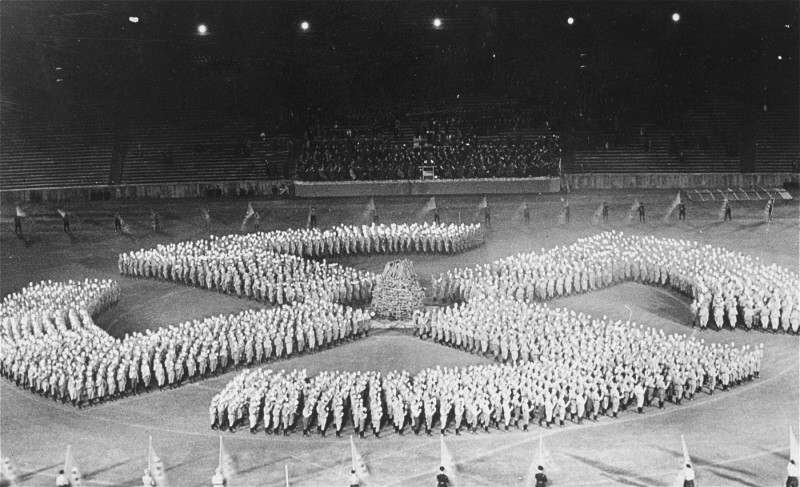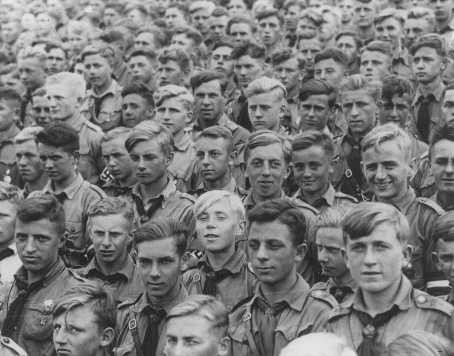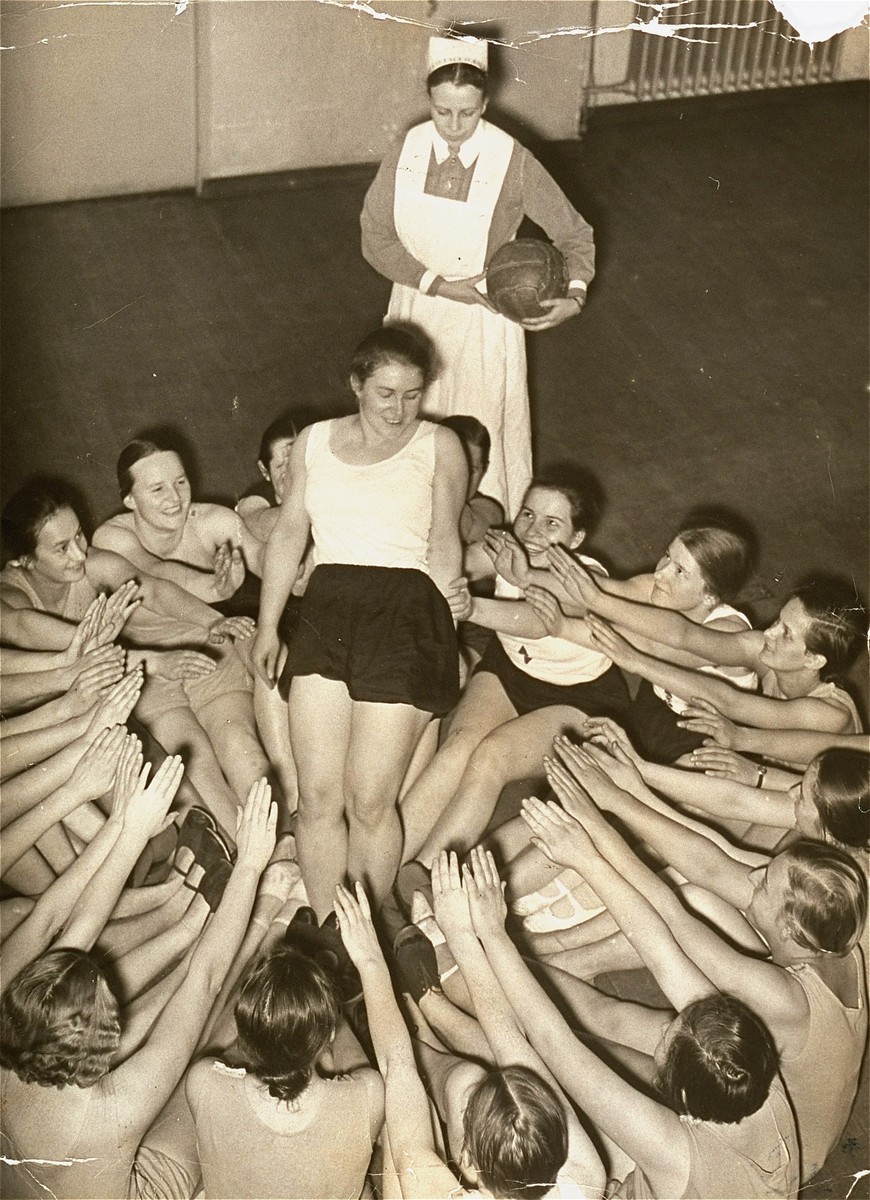
Hitler Youth
The Nazi Party tried to extend its influence over all aspects of German society. The Hitler Youth and the League of German Girls were developed as Nazi Party youth groups to introduce children and juveniles to Nazi ideology and policy. These youth groups also prepared Germany’s young people for war.
Key Facts
-
1
Over the course of the 1930s, the Nazi state abolished all other youth groups in Germany.
-
2
In 1939, more than 82% of eligible youth (ages 10-18) belonged to the Hitler Youth or its female equivalent, the League of German Girls.
-
3
While girls prepared for their futures as wives and mothers, boys participated in military training. In the last desperate months of the war, boys in their early teens were drawn into serving in the German civil defense and in the defensive militia called the Volkssturm (Home Guard).
The Hitler Youth (Hitlerjugend, or HJ) was the Nazi-organized youth movement. It was made up of different sections for boys and girls. The boys’ branch was simply called the Hitler Youth. The girls’ branch was called the League of German Girls (Bund Deutscher Mädel, BDM).
When the Nazis came to power in January 1933, the Hitler Youth movement had approximately 100,000 members. By the end of the same year, membership had increased to more than 2 million (30% of German youth ages 10-18). In the following years, the Nazi regime encouraged and pressured young people to join the Hitler Youth organizations. Enthusiasm, peer pressure, and coercion led to a significant increase in membership. By 1937, membership in the Hitler Youth grew to 5.4 million (65% of youth ages 10-18). By 1940 the number was 7.2 million (82%).
Significantly, Jews were not allowed to join these organizations. Jewish youth set up their own youth groups in Germany in the 1930s.
Youth Movements before the Nazi Takeover

Scouting and youth movements had been popular in Germany since the late nineteenth and early twentieth centuries. When the Nazis came to power in Germany in 1933, there were many political, social, and religious youth groups in existence. These youth groups often wore scouting uniforms.
One of these youth groups was the Hitler Youth, affiliated with the Nazi Party. Originally, the Hitler Youth was a Nazi youth group for boys. It was modeled after its adult counterpart, the Nazi paramilitary, called the SA (Sturmabteilung). The Hitler Youth was the Nazi Party’s second oldest paramilitary organ.
The organization began as the Youth League of the Nazi Party (Jugendbund der NSDAP) in March 1922. After the Nazis attempted to overthrow the German government during the Beer Hall Putsch in November 1923, the government temporarily banned Nazi organizations. This ban included the youth league. However, the youth movement secretly continued, most notably as the Greater German Youth Movement, founded in 1924. After the ban was lifted, the now official youth organization of the Nazi Party became the Hitler Youth, League of German Worker Youth (Hitler-Jugend, Bund deutscher Arbeiterjugend) in July 1926. This organization was officially incorporated into the SA.
Organizing Nazi Youth
As the Nazi Party gained popularity in the early 1930s, they wanted to increase their influence and reach with Germany’s youth. They expanded the Hitler Youth to include both boys and girls. By 1931, it had four sections organized by gender and age:
- German Youngsters (Deutsches Jungvolk) for boys 10 to 14 years old;
- Young Girls’ League (Jungmädelbund) for girls 10 to 14 years old;
- The League of German Girls (Bund Deutscher Mädel, or BDM) for girls 14 to 18 years old;
- Hitler Youth (Hitlerjugend) for boys 14 to 18 years old.
Later, the Nazis created a voluntary section of the League of German Girls for young women ages 17-21 called Faith and Beauty (Glaube und Schönheit).
In 1931, Baldur von Schirach became responsible for directing the entire Hitler Youth movement consisting of these four branches. Later in 1940, he became the Nazi Party chief (Gauleiter) of Vienna, but maintained a close tie with the youth movement. His replacement was 27-year-old Artur Axmann, a Hitler Youth leader.
Nazifying German Youth
The Role of Hitler Youth in the Nazi Regime
Beginning in 1933, the Hitler Youth and the League of German Girls had an important role to play in the new Nazi regime. Through these organizations, the Nazi regime planned to indoctrinate young people with Nazi ideology. This was part of the process of Nazifying German society. The aim of this process was to dismantle existing social structures and traditions. The Nazi youth groups were about imposing conformity. Youth throughout Germany wore the same uniforms, sang the same Nazi songs, and participated in similar activities.

One way the groups did this was to use the Hitler Youth movement to dominate the lives of Germany’s youth. Belonging to the organization was a significant time commitment. Hitler Youth members had to attend regular meetings and events. These interfered with other priorities, such as church and school.
This time commitment and regular exposure to Nazi ideology weakened the influence of parents, teachers, religious figures, and other voices of authority. In fact, the Hitler Youth and League of German Girls even encouraged members to report to their leaders about what was happening in their schools, churches, and families.
Consolidating the Youth Movement
The Nazi state wanted the Hitler Youth to be in charge of all German youth. They saw other youth movements as competition. In 1933, political youth groups were quickly incorporated or suppressed. However, apolitical and religious youth groups lasted well into the 1930s. The dissolution and incorporation of youth groups was part of a society-wide process called Gleichschaltung, or “coordination.”
In 1936, the Law Concerning the Hitler Youth stated: “The Hitler Youth encompasses all German youth within Reich territory.” With this law, the Hitler Youth staked its claim to all youth-related matters. Compliance was not, however, universal.
In March 1939, a new decree required all youth, ages 10 to 18, to join the Hitler Youth. From that point forward, the Hitler Youth became the only legal youth movement in Nazi Germany. The regime threatened to punish those who failed to comply.
Preparing Youth for the Future
The Nazi Party viewed youth as the foundation of a new world. Young people were future party members, mothers, and soldiers. The Nazis thus saw them as essential to the survival and health of the Volksgemeinschaft (“People’s Community”). They hoped to teach children to be both racially conscious and physically fit in order to build a new future for Germany. As a symbol of the future, the Hitler Youth were often present at Nazi Party rallies and marches, including the annual Nuremberg rallies. Leni Riefenstahl’s film Triumph of the Will (Triumph des Willens) shows Hitler speaking to, and then greeting, members of the Hitler Youth at the 1934 Nuremberg Rally.
Hitler Youth

The Hitler Youth was a paramilitary organization. It was designed to train boys as future fighters and soldiers for the Nazi cause. As an official organization of the Nazi state, the Hitler Youth had a military structure at the local, regional, and national levels.
Boys practiced military drills and learned to handle weapons. They also worked on farms in the summer and participated in competitive sports, especially boxing. Some boys enjoyed the physical challenge, competition, and camaraderie. Others, however, found the constant focus on preparing for war and sacrificing themselves for the fatherland overwhelming and alienating.
The League of German Girls
The League of German Girls was intended to prepare girls to be future wives and mothers. Girls also participated in physical activities, such as gymnastics. Girls’ sports tended to be collective and synchronized, rather than competitive and individual. These activities served to demonstrate the value of working together. The League trained girls to care for the home and family. Girls learned skills such as sewing, nursing, cooking, and household chores.
Youth in Opposition
The Nazi state tried to create a homogenous youth culture through its Hitler Youth organizations. However, some youth refused to participate. Sometimes this was a political or religious statement. At other times their refusal was based on adolescent rebellion or individualism.
Especially common in big cities, illegal youth groups rejected Hitler Youth culture. These youth groups tended to dislike conformity and militarization. They typically wore different styles of clothing and engaged in less structured social activities. Many illegal youth groups were for both girls and boys. Some even encouraged more fluid gender roles than the rigid Hitler Youth structure allowed.
These informal, alternative youth groups each took on their own characteristics. The Leipzig Meuten were a Communist-inspired anti-Nazi group. The rough and tumble Edelweiss Pirates sometimes physically fought with Hitler Youth members. The Swing Kids—an alternative youth group most prominent in Hamburg—danced swing and listened to jazz. They wore their hair long and dressed in an American or British style.
These rebellious youth ran the real risk of being arrested by the Gestapo and imprisoned in concentration camps.
Mobilizing Youth for War
By the outbreak of war in 1939, the Hitler Youth had already prepared a generation of young people to fight the war and occupy foreign territory. The young men and women who had joined the Hitler Youth in the early 1930s had been taught practical skills and Nazi ideas. Those who had already turned eighteen used this knowledge to serve the German war effort. They worked as soldiers, policemen, secretaries, nurses, and doctors.
The next generation of Hitler Youth members were still too young to join the military and other Nazi organizations. But, they too had a role to play in the war. The Hitler Youth and the League of German Girls participated in war-related relief activities. For example, they organized care packages for troops at the front.
Older boys and girls even deployed to some of the territories annexed by Germany before and at the start of the war. The Nazis believed that ethnic German populations living outside the borders of prewar Germany needed to be re-Germanized. The Hitler Youth taught the German language and other German cultural traditions in these communities.
The End of the War
As it became clear that Nazi Germany was losing the war, the Nazi regime faced manpower shortages. Allied air raids destroyed large parts of German cities. This created logistical problems and worsened housing and supply shortages. During raids, the regime used teenagers to operate anti-aircraft rifles. In the aftermath, youth also helped civilians displaced by the destruction through a variety of relief activities. For example, girls worked in soup kitchens, helped those whose homes had been destroyed, and served as nurses’ aids.
In 1943, the Waffen-SS formed a special division made up of Hitler Youth. This division consisted of boys born in the year 1926 (making them 16 or 17 years old in 1943). The division first deployed to France. There, it perpetrated several massacres, such as the Ardenne Abbey massacre of Canadian prisoners of war. This division also carried out the reprisal killing of French men, known as the Ascq massacre. In addition, these youths fought Allied troops in the Battle of Normandy in France and in the Battle of the Bulge in Belgium.
In the final months of the war, males aged 16 to 60 were inducted into a new defensive militia called the Volkssturm (lit. People’s Storm). This militia joined the regular military in the last defensive battles against Allied troops.
Poorly equipped and inadequately trained, thousands of youths fought and died for the German war effort even as defeat had become inevitable.
After the War
Like the Nazi Party, the Hitler Youth and the League of German Girls were outlawed after the war. By that time, however, millions of youth and young adults had spent their formative years as members of Hitler Youth organizations. These organizations thus had an enormous influence on twentieth century German society.
Footnotes
-
Footnote reference1.
According to Gerhard Rempel, Hitler’s Children: The Hitler Youth and the SS (Chapel Hill: University of North Carolina Press, 2015), p. 268.
Critical Thinking Questions
Why did the Nazis want every child in Germany to join a Nazi youth group?
What might have led young people to join Nazi youth groups or to oppose joining these groups?
What role did the German youth play in the war?

